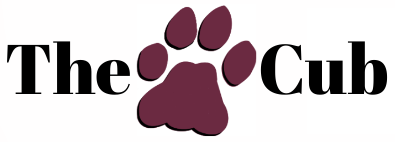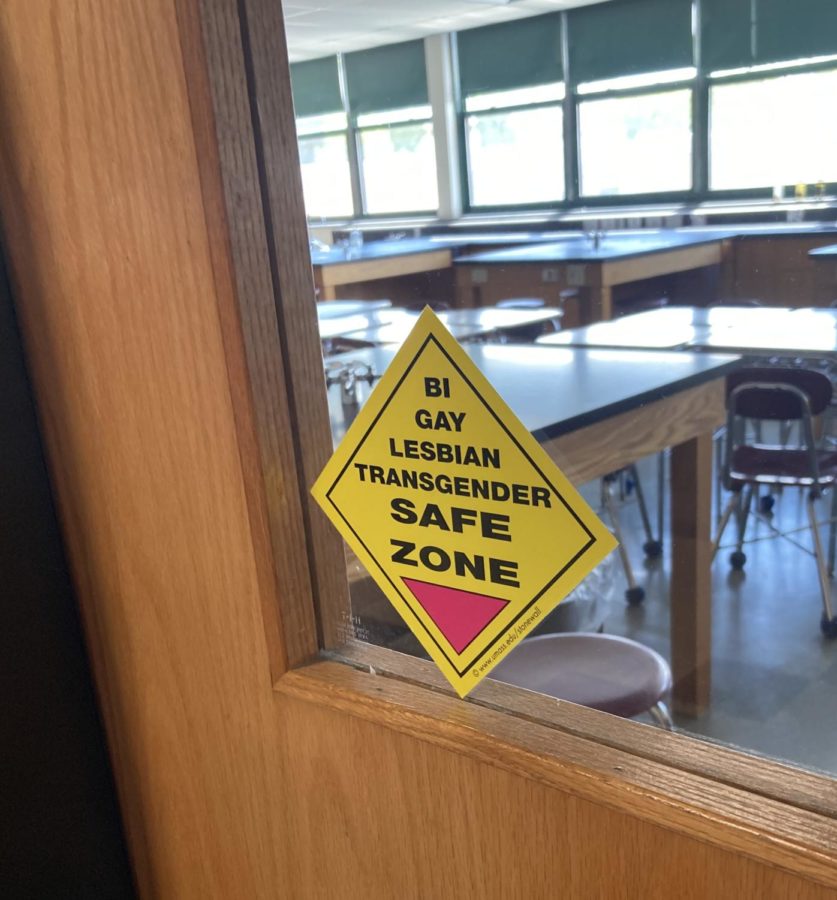GSA: How A Club Saves Students’ Lives
May 19, 2022
It’s bleak, walking through the halls at Ludlow High School. The world towers above my shoulders, and second glances meet my skin, sending phantom pinpricks across my pores, other’s disapproval seeping into my soul and ripping away any possible sense of joy. It’s not my clothing making the bathroom monitor furrow her eyebrows and glance down where my fingers intertwine with paler ones. Her reaction follows nothing more than two people with long hair and winged eyeliner: two girls holding hands at LHS.
It’s not as if it’s something limited to the halls of high school, the second glances (and screams, and spit, and slurs) seem to follow my every footstep, making simply walking around town with my girlfriend a nightmare.
The first time my partner and I had the confidence to walk around town holding hands, it only took twenty minutes for a “kind, old gentleman” to tell us we were “damning the children of this world” by “influencing their innocent thoughts.”
Often, others’ words attempt kindness, with no intention of forging an attack. Instead, their hurtful comments are brought about by a lack of understanding. Boys who inform us they were only giving us “those” looks because “they weren’t sure what we were,” and girls who “yas” at any mention of anything queer, even when it’s conversion therapy, something countless youths suffer through.
These experiences weigh on you, destroying your mental health, and slowly killing you from the inside; at least, when it’s kept bottled up. It’s these experiences that more than 50 students at LHS lived through, and it’s these 50 students who meet at LHS’s GSA, the only safe space at LHS for them.
According to Child Trend’s definition, a GSA (or Gender-Sexuality Alliance) is a student-run club, where students meet with other LGBTQ+ students and allies to discuss discrimination in their lives, and work together to find a solution.
With recent cuts in the community, students at LHS’ GSA ponder one question: “Are we next?”
However, the community should work together to create more safe spaces, instead of trying to take them away.
In school and in society, the lives and safety of LGBTQ+ students are among the most at risk. Healthline’s statistics report 52% of LGBTQ+ students reporting bullying, and NBC reports 46% of transgender adults report verbal harassment, and 10% of transgender adults report physical harassment.
In addition, LGBTQ+ youth are at risk at home. Oregon Courts report that 34% of LGBTQ+ youth are physically abused at home as a result of their sexual orientation or gender identity, and 26% of LGBTQ+ youth are homeless.
It’s these statistics many students don’t know. These numbers won’t lower until students learn LGBTQ+ history and accept their peers. There’s only one issue with teaching LGBTQ+ history: it isn’t a curriculum requirement. Therefore, it isn’t taught in schools. This leaves GSA’s to teach students LGBTQ+ history and educate students about the risks LGBTQ+ students face.
With the increase in acceptance education brings, students form bonds with one another. This allows students to better understand those who are different from themselves. As these educated students grow into adults, with partners and children of their own, their willingness to accept a queer child rises, lowering the likelihood of LGBTQ+ children becoming homeless and abused.
Because of risk factors like these, LGBTQ+ youth have clear disadvantages in both their general life and in their education. Students are more likely to drop out of school in order to work, limiting them to higher education and higher paying jobs. This subsequently puts LGBTQ+ people at a disadvantage as a whole, as there are less opportunities for political advancements and political power. Of course, this limits the legislation passed to protect the LGBTQ+ community, as it has to rely on allies for protection.
Gender-Sexuality Alliances allow students to work with their allies and educate the rest of their community, promoting tolerance. It further solidifies LGBTQ+ students as part of the school community, forcing students of different backgrounds to form bonds with each other.
Amid a climate of hostility, this acceptance keeps students motivated to live and learn. Many students don’t have accepting relationships outside of those in a GSA, leaving the club, with both its allies and members, as the sole support system for these students.
Before joining GSA, many LGBTQ+ students feel invisible, and as if their voice doesn’t matter. They don’t see themselves represented anywhere, neither with their classmates, on screen, or in politics. This limits their ambitions, as no one like them had previously done what they’re dreaming of, so how could they?
The students in GSA admit the relationships they form there make them feel seen, a rare feeling for most LGBTQ+ students. Surrounded by others like yourself, and others who accept you as you keeps students motivated to keep reaching their dreams. American Education Research Association says that a GSA limits the 33% drop out rate of LGBTQ+ students in America.
Furthermore, more LGBTQ+ friendly schools have higher GPAs amongst their LGBTQ+ students. According to American Education Research Association, in unaccepting high schools, the average straight and cisgender student has a GPA of 3.3, while LGBTQ+ students have an average GPA of 2.8. In a supportive environment, these two GPAs even out, giving all students an equal opportunity at success.
GSA Advisor Heather Pighetti says this: “LGBTQ students need a safe space within a school to feel comfortable and to be able to connect with one another. They need a place where they can share their feelings and experiences and know that they are not alone.”
LGBTQ+ students have some of the highest rates of mental health issues, homelessness, and abuse, all of which stem from experiences with homophobia. Having a community where students can discuss the issues they’re having leads to its success. When students can make friends with those in the club, it gives them access to a constant support system.
One student, Storm G, says “having a community that openly accepts you and having others who are like you is very nice. GSA makes me feel like I have a home with the people I care about.”
A GSA doesn’t only allow students to discuss discrimination, but also create and maintain friendships. Above all, a GSA thieves off its identity as a social club, emphasizing the importance of relationships between people.
“It’s nice to see some of my friends who I don’t have classes with and have meaningful conversations with them on a weekly basis,” adds another student.
It’s bonds like these limiting the serious risks LGBTQ+ students have to their mental health. The Trevor Project reports 1.8 million LGBTQ+ youth admitting to seriously considering suicide each year, making it vital for students to have support systems.
Advisor Mrs.Pighetti adds students “need to know they are valued, that they are loved, and that they belong.” It’s these feelings that limit the risk of suicide, and its a GSA that creates these feelings for LGBTQ+ youth.
LGBTQ+ youth aren’t depressed because of their sexuality, but because of environmental factors: homophobia, discrimination, and stigmatization. Because a GSA works to limit all three of these, the club helps the mental health of LGBTQ+ students.
In the current world, where discussions of sexuality are censored, stigmatization continues to prevail, leaving only the stigmatized group itself to discuss the issues against their community.
According to BACP, when a group discusses their issues it allows them to discover new ways to cope and discuss self-care strategies. Talking about mental health in a group also allows for one to accept their own issues, and begin to work past them. Most importantly, those in the group must know there isn’t judgment for any mental health issues.
“The GSA is a safe space, it’s where I can vent about some things that may not be going so well in my life and I know no one will judge me,” one student says.
Students in the club agree to this, stating: “GSA has helped me get out of a lot of dark places.”
Students in the club also admit it helps them accept their identity. Many LGBTQ+ youth still struggle to fully accept themselves, and many develop mental health issues because of this struggle.
Being surrounded by those who identify similarly to yourself eliminates this time of confusion, and allows students mental health to prosper. Students in GSA can discuss their own identities, which often helps other students discover their own identities, or discover others who think similarly to themself.
“ It has been very helpful coming to terms with my own sexuality and gender identity,” One student reports, adding “I’ve had lots of internalized transphobia, but it has gotten much better since I joined GSA.”
Through Ludlow High School’s GSA, students can accept themselves, improve their mental health, and create relationships with other students. This club is a vital part of the school community, and one in need of expansion, not destruction. A school’s GSA is the heart of their community, and something keeping students motivated to continue learning.
References
“Depression | How Counselling Can Help.” British Association for Counselling and Psychotherapy, https://www.bacp.co.uk/about-therapy/what-therapy-can-help-with/depression/. Accessed 18 May 2022.
Mastroianni, Brian. “LGBTQ Youth Are Still Experiencing High Rates of Bullying.” Healthline, Healthline Media, 14 Oct. 2021, https://www.healthline.com/health-news/lgbtq-youth-are-still-experiencing-high-rates-of-bullying-in-person-and-online.
“National Estimate of LGBTQ Youth Seriously Considering Suicide – The Trevor Project.” The Trevor Project, https://www.facebook.com/TheTrevorProject, 27 June 2019, https://www.thetrevorproject.org/blog/national-estimate-of-lgbtq-youth-seriously-considering-suicide/.
“Only 3 States Have a Gay-Straight Alliance in More than Half of Their High Schools – Child Trends.” Child Trends, https://www.facebook.com/childtrends/, 5 Nov. 2019, https://www.childtrends.org/blog/only-3-states-have-a-gay-straight-alliance-in-more-than-half-of-their-high-schools.
Yurcaba, Jo. “Anti-Gay Hate Crimes Fell Slightly in 2020, While Anti-Trans Crimes Rose, FBI Says.” NBC News, NBC News, 1 Sept. 2021, https://www.nbcnews.com/nbc-out/out-news/anti-gay-hate-crimes-fell-slightly-2020-anti-trans-crimes-rose-fbi-say-rcna1846.
https://www.courts.oregon.gov/programs/crb/training/Training%20Center/W11.YouthRiskFactorsHO.pdf. Accessed 18 May 2022.
https://www.utep.edu/education/el3lab/_Files/docs/LGBTQ-Fact-Sheet—Student-Achievement-and-Educational-Attainment.pdf. Accessed 18 May 2022.


